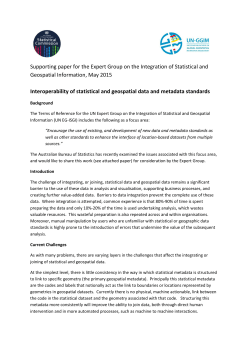
(How) Does Data-âbased Music Discovery Work?
(How) Does Data-‐based Music Discovery Work? Akarapat Charoenpanich, London School of Economics Aleksi Aaltonen, Warwick Business School Context and moGvaGon • Music industry has been significantly transformed by digital technology. – Digital ecosystem effec9vely abolish constraints on music distribu9on – Music / product space available to consumers become extremely large • Key problem: Music discovery. – Given an extremely large music / product space, how do people learn what they want to listen to? – Exploratory search becomes very important, contrast to known-‐item search • Business opportunity – New form of music discovery to help people to listen to music that beIer match their taste Research quesGon • Empirical object: Last.fm • Research quesGon: Does the new form of music discovery in Last.fm provide value to consumers? • Amount of music consump9on as indicator for value – Main dependent variable in our sta9s9cal analysis – Not direct measure of commercial success – But possibly associated with public valua9on (Brynjolfsson, Kim and Oh, 2013) • Able to obtain a representa9ve sample of user – Rejec9on sampling. Select user by their iden9fiers randomly – End up with random sample of around 13K Briefly about Last.fm • PlaWorm for music discovery Last.fm user growth founded in 2002 • Policy change in 2009 – Restrict free music streaming services – Impact on user growth Free music streaming from Last.fm 20.8 20.0 Wound down 10.4 6.5 4.0 1.8 0 .4 0.0 music 16.4 streaming services 11.1 7.2 1.4 200 200 200 200 200 200 200 201 201 201 201 201 – Deploy collabora9ve filtering recommender system and social media feature – Users submit data to Last.fm – Last.fm provide personalized music recommenda9on Unit: User proporGon by year of registraGon Music discovery (and consumpGon) through Last.fm: 3 crucial factors can be idenGfied 1 CollaboraGve filtering recommender system 2 -‐ Popular approach for product recommenda9on -‐ Construct similarity network linking music items together u9lizing social data submiIed by its users -‐ Recommend products similar to those that users like in the past according to constructed similarity network Social media features -‐ Enhance both music discovery and music consump9on -‐ Idiosyncra9c links by pos9ng, commen9ng etc. and these links can be seen as their personal recommenda9on -‐ Similarity network + social network = dual network AutocorrecGon system (metadata infrastructure) -‐ Help to improve quality of social data as there exist no authority to control for music metadata standard -‐ Metadata need to be associated with the right content . Iden9fiers become very important. But there are more than 100 ways to spell Guns N’ Roses -‐ Last.fm implement autocorrec9on system in January 2009 to alleviate the problem 3 TheoreGcal model and esGmaGon • With Last.fm data, es9mate the model twice TheoreGcal model Use of data analytics H3 Music discovery H5 Metadata quality – Before 2009 – 2009 and onward H1 Music consumption H4 Use of social media Model 2: Music discovery H2 Model 1: Music consumption • Why? – To see impact of policy changes on consumer offering in 2009 through intercept terms (negaGve) – To assess impact of autocorrec9on system which has been implemented in 2009 (posiGve) Data collecGon: Assembly of dataset 1 2 PLAYCOUNT LISTENING CONCENTRATION -‐ Measure music consumpGon -‐ Count number of listening event during different years -‐ Measure success of music discovery -‐ Successful music discovery more concentrated listening profile at level of ar9st. Apply normalized Herfindahl Index (HI) 3 NUMBER OF FRIENDS -‐ Measure social media engagement -‐ Compute a proxy variable to track number of friends through 9me 4 NUMBER OF CORRECTION -‐ Measure metadata quality -‐ With auto-‐correc9on mapping applied to listening event data of user, compute a proxy variable to trace number of correc9on through 9me PAST LISTENING SIMILARITY -‐ Measure use of data analyGcs -‐ Why? Crux of recommender system => recommend products similar to those users like in the past -‐ With similarity network, compute a proxy variable to trace past listening similarity of user through 9me 5 Music consumption model Dependent variable: Success of music discovery Dependent variable: Music consumption (Constant) Use of data analytics Metadata quality Social media engagement (Constant) Use of data analytics Metadata quality Social media engagement Beta Sig. 3.66 0.00 0.40 0.00 0.10 0.08 2.25 0.81 0.33 0.13 0.00 0.06 0.00 0.00 0.00 0.01 Before 2009 Music discovery model (constant) Success of music discovery Social media engagement 2009 and onward 2009 and onward Before 2009 EsGmaGon result (constant) Success of music discovery Social media engagement Beta Sig. 3.64 0.00 0.38 0.00 1.05 0.00 2.38 0.47 0.00 0.00 1.36 0.00 EsGmaGon result: direct, indirect and total effect on music consumpGon The direct and indirect impact of data analytics, data quality, social media engagement and policy changes upon music consumption Increase in use of data analytics by 1% Increase in metadata quality by 1% Increase in use of social media by 1% Changes to consumer offerings Direct n/a n/a +1.05% n/a Before 2009 Indirect +0.15% +0.04% +0.03% n/a Total +0.15% +0.04% +1.08% n/a 2009 and after Direct Indirect Total n/a +0.30% +0.30% n/a +0.12% +0.12% +1.36% +0.05% +1.41% -71.7% -35.2% -81.3% Although new form of music discovery is valuable its value is rela7vely modest as compared to that derived from music acquisi7on Discussion and conclusion • Call aIen9on upon assump9on underpinning product/service innova9ons based on big data – Can big data resources underlying Last.fm lead to enough compe99ve advantage? – Last.fm made a loss of 2 million GBP last year – Rela9vely small propor9on of music enthusiast, who value successful music discovery highly • Theorize on dynamics of this kind of business venture – Changing user dynamics and unexpected secondary effects – Ini9al reduc9on of user base lower value of social media, and cannot counter that by improving music discovery features – Self-‐propaga9ng decline of user base – Network externali9es in the realm of big data
© Copyright 2025





















